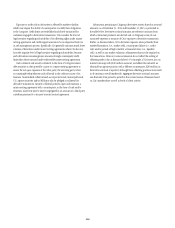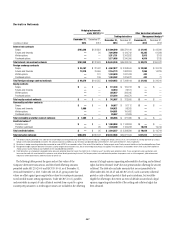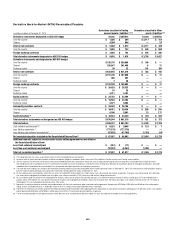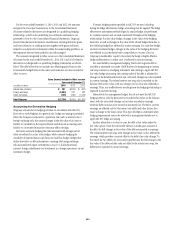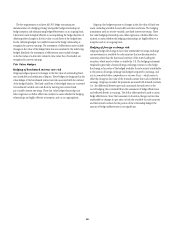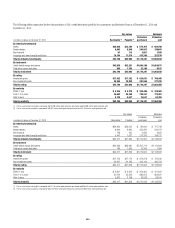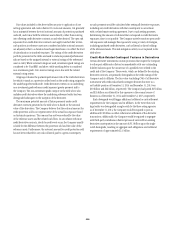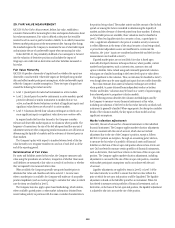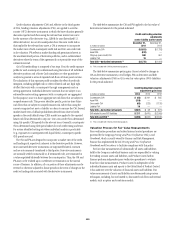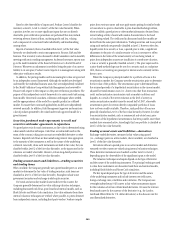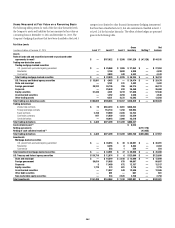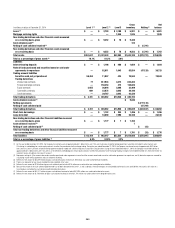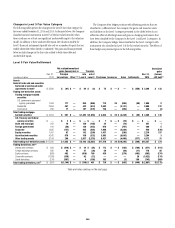Citibank 2014 Annual Report Download - page 273
Download and view the complete annual report
Please find page 273 of the 2014 Citibank annual report below. You can navigate through the pages in the report by either clicking on the pages listed below, or by using the keyword search tool below to find specific information within the annual report.256
Fair values included in the above tables are prior to application of any
netting agreements and cash collateral. For notional amounts, Citi generally
has a mismatch between the total notional amounts of protection purchased
and sold, and it may hold the reference assets directly, rather than entering
into offsetting credit derivative contracts as and when desired. The open risk
exposures from credit derivative contracts are largely matched after certain
cash positions in reference assets are considered and after notional amounts
are adjusted, either to a duration-based equivalent basis or to reflect the level
of subordination in tranched structures. The ratings of the credit derivatives
portfolio presented in the tables and used to evaluate payment/performance
risk are based on the assigned internal or external ratings of the referenced
asset or entity. Where external ratings are used, investment-grade ratings are
considered to be ‘Baa/BBB’ and above, while anything below is considered
non-investment grade. Citi’s internal ratings are in line with the related
external rating system.
Citigroup evaluates the payment/performance risk of the credit derivatives
for which it stands as a protection seller based on the credit rating assigned to
the underlying referenced credit. Credit derivatives written on an underlying
non-investment grade reference credit represent greater payment risk to
the Company. The non-investment grade category in the table above also
includes credit derivatives where the underlying referenced entity has been
downgraded subsequent to the inception of the derivative.
The maximum potential amount of future payments under credit
derivative contracts presented in the table above is based on the notional
value of the derivatives. The Company believes that the notional amount for
credit protection sold is not representative of the actual loss exposure based
on historical experience. This amount has not been reduced by the value
of the reference assets and the related cash flows. In accordance with most
credit derivative contracts, should a credit event occur, the Company usually
is liable for the difference between the protection sold and the value of the
reference assets. Furthermore, the notional amount for credit protection sold
has not been reduced for any cash collateral paid to a given counterparty,
as such payments would be calculated after netting all derivative exposures,
including any credit derivatives with that counterparty in accordance
with a related master netting agreement. Due to such netting processes,
determining the amount of collateral that corresponds to credit derivative
exposures alone is not possible. The Company actively monitors open credit-
risk exposures and manages this exposure by using a variety of strategies,
including purchased credit derivatives, cash collateral or direct holdings
of the referenced assets. This risk mitigation activity is not captured in the
table above.
Credit-Risk-Related Contingent Features in Derivatives
Certain derivative instruments contain provisions that require the Company
to either post additional collateral or immediately settle any outstanding
liability balances upon the occurrence of a specified event related to the
credit risk of the Company. These events, which are defined by the existing
derivative contracts, are primarily downgrades in the credit ratings of the
Company and its affiliates. The fair value (excluding CVA) of all derivative
instruments with credit-risk-related contingent features that were in a
net liability position at December 31, 2014 and December 31, 2013 was
$30 billion and $26 billion, respectively. The Company had posted $27 billion
and $24 billion as collateral for this exposure in the normal course of
business as of December 31, 2014 and December 31, 2013, respectively.
Each downgrade would trigger additional collateral or cash settlement
requirements for the Company and its affiliates. In the event that each
legal entity was downgraded a single notch by the three rating agencies
as of December 31, 2014, the Company would be required to post an
additional $2.0 billion as either collateral or settlement of the derivative
transactions. Additionally, the Company would be required to segregate
with third-party custodians collateral previously received from existing
derivative counterparties in the amount of $0.1 billion upon the single
notch downgrade, resulting in aggregate cash obligations and collateral
requirements of approximately $2.1 billion.


